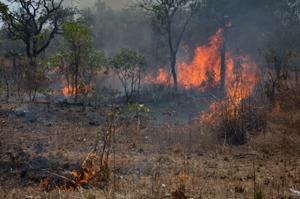
ALAN TAYLOR uncovers some facts about bushfires in Australia…
Bushfires are a part of life in Australia. Here – as the country enters another bushfire season – are 10 facts about them you may not be aware of:

PICTURE: Kaszojad/www.istockphoto.com
• A bushfire front will travel much faster up slopes than down slopes. Its speed will double every 10 degrees of slope.
• In Australia, eucalyptus trees provide the perfect fuel for bushfires. This is due to eucalyptus oil being flammable. In fact, eucalyptus trees have been known to explode in the most intense fires.
• Bushfires occur more frequently on Sundays than any other day.
• Some plants, such as the Banksia, rely on the heat of bushfires to open their seed pods and release the seeds. The seeds allow the plant to regenerate by falling onto the fertilised soil.
• Ember attacks are the main cause of homes burning in a bushfire. Embers set alight dry leaves and twigs in the guttering of the house, blow under doors and into cracks. They can arrive up to an hour before the main fire.
• The causes of bushfires can be split into two groups, natural and human causes. Of the natural group, lightning is the common cause. Of the human group, the common cause is arson.
• Articles collected after Australia’s deadliest bushfire, known as Black Saturday, demonstrate the extreme heat of a bushfire. In Kinglake West, Victoria, two broken ceramic bowls were found fused together by a molten mass of ceramic. Ceramic melts at between 2000 and 3000 degrees Celsius.
• People sustain more injuries falling from roofs while hosing their homes down in a bushfire than from burns. All hosing should be done from the ground, not only to prevent injuries, but to allow a rapid escape if necessary.
• Bushfires can alter the water quality of streams, ponds and catchments due to erosion caused by the changed structure of the soil. The burning of vegetation surrounding areas of water causes an increase light levels, which can cause an increase in bacteria. When combined with a higher water temperature, the increase in bacterial activity can reduce oxygen levels in the water. Fish suffocation can be the result.
• Heavy rainfall after a bushfire can wash exposed toxins into water catchments. Catchment water may need further treatment than is normally required in order for the water to be fit for agricultural or human consumption.
Sources: Geoscience Australia, NSW Rural Fire Service, 2009 Victorian Bushfires Royal Commission, Museum Victoria, Department of the Environment





